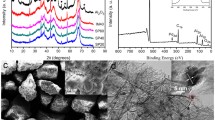Abstract
This study tested the selectivity and sustainability of an alumina-supported Pd–In bimetallic catalyst for nitrate reduction with H2 in a continuous-flow packed-bed reactor in the presence of: (i) dissolved oxygen (DO), an alternative electron acceptor to nitrate, (ii) variable NO3 −:H2 influent loadings, and (iii) the presence of a known foulant, sulfide. The sustainability of the catalyst was promising, as the catalyst was found to be stable under all conditions tested with respect to metal leaching. The presence of DO at concentrations typical of treatment conditions will increase H2 demand for NO3 − reduction, but has no negative impact on the selectivity of the catalyst. Under optimal conditions, i.e., a pH of 5.0 and a high NO3 −:H2 influent loading, low NH3 selectivity (5%) was achieved for extended periods (36 days), resulting in sustained levels of NH3 that approached the European legal limit. The biggest challenge to the sustainability of the catalyst was the addition of sulfide, that initially increased NH3 selectivity and ultimately resulted in complete deactivation of the catalyst. Further work is required to identify regeneration methods to restore sulfide-fouled catalyst activity and selectivity; however, the most effective use would be to remove sulfide prior to catalytic treatment.



Similar content being viewed by others
References
U.S. Environmental Protection Agency (2000) National water quality inventory. Office of Water, Washington, DC
Horold S, Vorlop KD, Tacke T, Sell M (1993) Catal Today 17:21
Pintar A, Vetinc M, Levec J (1998) J Catal 174:72
Vorlop K-D and Prüsse U (1999) Imperial College Press, London
Prusse U, Vorlop K-D (2001) J Mol Catal A 173:313
Yoshinaga Y, Akita T, Mikami I, Okuhara T (2002) J Catal 207:37
Palomares AE, Prato JG, Rey F, Corma A (2004) J Catal 221:62
Nakamura K, Yoshida Y, Mikami I, Okuhara T (2006) Appl Catal B 65:31
Sakamoto Y, Kanno M, Okuhara T, Kamiya Y (2008) Catal Lett 125:392
Chaplin BP, Roundy E, Guy KA, Shapley JR, Werth CJ (2006) Environ Sci Technol 40:3075
Chaplin BP, Shapley JR, Werth CJ (2007) Environ Sci Technol 41:5491
Nyberg C, Tengstal CG (1984) J Chem Phys 80:3463
Mitsui T, Rose MK, Fomin E, Ogeltree DF, Salmeron M (2002) J Chem Phys 117:5855
Constantinou CL, Costa CN, Efstathiou AM (2007) Environ Sci Technol 41:950
Daum J, Vorlop KD (1999) Chem Eng Technol 22:199
Prusse U, Hahnlein M, Daum J, Vorlop K-D (2000) Catal Today 55:79
Kroeze C (1994) Sci Total Environ 143:193
Pintar A, Batista J (1999) Catal Today 53:35
Chaplin BP (2007) Ph.D. Thesis, University of Illinois at Urbana-Champaign
Acknowledgments
This work was supported by Water CAMPWS, a Science and Technology Center program of the National Science Foundation under agreement number CTS-0120978. We also thank Dr. Naoko Munakata for her assistance in reactor setup.
Author information
Authors and Affiliations
Corresponding author
Rights and permissions
About this article
Cite this article
Chaplin, B.P., Shapley, J.R. & Werth, C.J. The Selectivity and Sustainability of a Pd–In/γ-Al2O3 Catalyst in a Packed-Bed Reactor: The Effect of Solution Composition. Catal Lett 130, 56–62 (2009). https://doi.org/10.1007/s10562-009-9883-4
Received:
Revised:
Accepted:
Published:
Issue Date:
DOI: https://doi.org/10.1007/s10562-009-9883-4




